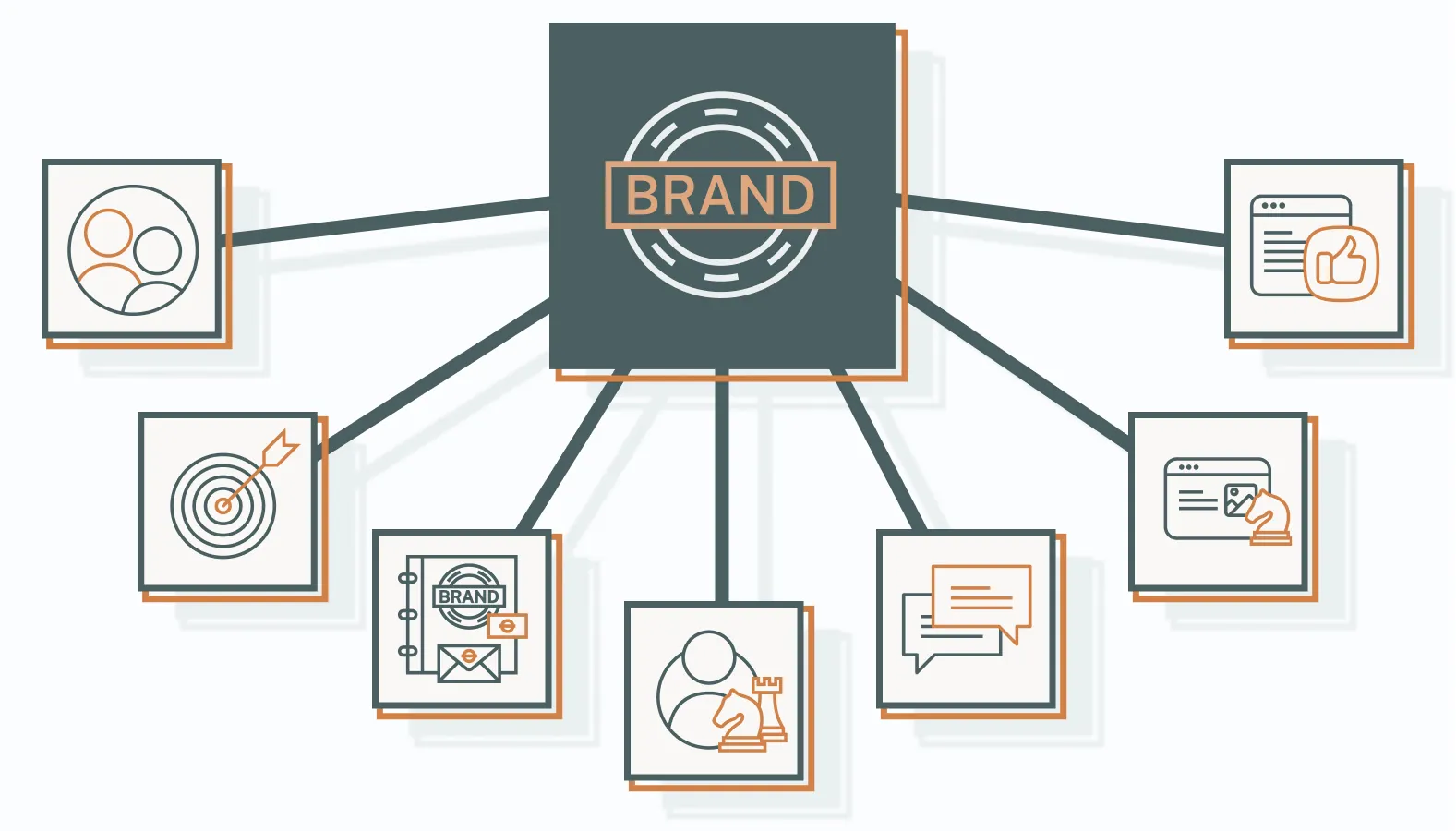You can’t afford to be forgettable.
Getting clicks is easy. Building a brand people remember and come back to is where the real work (and ROI) begins. Most ecommerce businesses chase traffic and conversions but ignore the long game: brand equity.
Branding isn’t just about looking good. It’s about owning perception at every touchpoint, from homepage to help desk. It’s the reason someone buys from you and not the ten identical shops a click away.
If you’re serious about scaling in 2025, you need more than tactics. You need a brand strategy built to outlast algorithms, trends, and your competitors’ ad budgets.
Here are 10 that actually work.
The Concept of Ecommerce Branding
Branding in ecommerce is more than visual appeal. It’s how your business is recognized, trusted, and remembered across every touchpoint. From your homepage to post-purchase emails, branding connects the dots and builds a coherent customer experience.
What Ecommerce Branding Means
At its core, branding is the strategic process of defining how your online store looks, sounds, and feels. It shapes perception and sets the tone for customer relationships.
A strong ecommerce brand is built on:
- Visual Identity: Logo, colors, fonts, and design that reflect your values
- Messaging and Voice: Clear language and tone that consistently express who you are
- Customer Experience: Every step of the journey, from discovery to delivery
- Core Values: What your business stands for, and why that matters to your audience
Branding isn’t limited to what you sell. It’s how you sell it and how it makes people feel. The right strategy builds emotional equity, not just visual recognition.
Why It Matters More Than Ever
Online retail is crowded. A compelling brand cuts through the noise, separates you from the competition, and gives shoppers a reason to choose you.
Strong ecommerce branding:
- Drives differentiation in a market full of clones
- Builds trust with buyers who want consistency and professionalism
- Encourages loyalty by making your brand feel familiar and dependable
- Enhances memorability, turning one-time customers into repeat advocates
The landscape has shifted. Social media, AI-powered personalization, and on-demand support have raised the bar. Shoppers expect relevance, transparency, and a clear point of view.
The takeaway: ecommerce branding is a long game. It shapes perception, strengthens retention, and future-proofs your growth in a market where loyalty is earned, not assumed.
Why E-commerce Branding is Crucial for Success
Strong branding isn’t a nice-to-have. It’s the engine behind customer acquisition, conversion, and long-term retention — and it should be treated like it.
Cut Through the Noise
The average shopper sees hundreds of offers a day. A distinct brand makes yours the one they remember.
When branding is clear and consistent, it:
- Boosts recognition so customers recall your store on the first scroll
- Establishes trust before they ever click “Buy”
- Creates clarity in a sea of lookalike product pages
You’re no longer competing on features alone. You’re competing on perception. And perception is where brand wins.
Build Loyalty That Lasts
Trust is the currency of ecommerce. The more reliable your brand feels, the easier it becomes to turn new buyers into returning customers.
A well-positioned brand:
- Aligns with customer values
- Builds emotional connections through storytelling and experience
- Reinforces your promise at every interaction
Great brands go beyond transactions. They turn purchases into preferences, and preferences into loyalty.
Protect Your Position
In saturated markets, brand is your competitive moat. Products can be copied. Brand identity can’t.
Distinct branding:
- Shields you from price wars
- Makes it more challenging for competitors to replicate your positioning
- Elevates your business from “store” to “experience”
In short, branding influences every phase of the funnel. From first touch to lifetime value, it drives performance where it counts and keeps customers coming back for reasons that go deeper than product specs.
Essential Strategies for Ecommerce Branding
Branding doesn’t happen by accident. To build an ecommerce brand that sticks, you need a deliberate, cross-functional strategy that aligns positioning, voice, experience, and technology across every customer interaction.
Below are seven core strategies. Each one drives clarity, trust, and relevance across the digital customer journey.
1) Know Your Audience Like a Strategist, Not a Statistician
You’re not marketing to a persona on a slide. You’re solving problems for real people. Start with baseline demographics, but don’t stop there.
Go deeper with:
- Behavioral patterns: browsing habits, buying cycles, price sensitivity
- Psychographic data: values, lifestyle drivers, emotional triggers
- Decision dynamics: who influences them, what builds trust, what raises doubt
Use first-party data, heatmaps, post-purchase surveys, and social insights to sharpen your understanding. When you know what your audience cares about, you stop guessing and start converting.
Pro tip: Build micro-segments based on behavior, not just demographics. One-size-fits-all messaging leaves revenue on the table.
2) Anchor Your Brand with a Clear Mission and Vision
Your brand exists for a reason beyond product margins. That reason should be easy to explain, yet impossible to ignore.
- Mission: What change are you here to make?
- Vision: What does the world look like when you’ve succeeded?
Avoid corporate speak. Get specific. A compelling mission earns internal alignment and customer advocacy. A sharp vision gives your brand direction in a sea of sameness.
Pro tip: Test mission clarity internally. If your team can’t explain it in 10 seconds, it’s not working externally either.
3) Make Your Brand Values Actionable, Not Aspirational
Too many brands treat values like décor: nice to have, but rarely used. Instead, use them as operational guardrails.
Define 3–5 brand values that:
- Reflect on how your team makes decisions
- Resonate with your ideal customer
- Set you apart from commoditized competitors
Then operationalize them. Train staff on them. Use them to shape copy, product choices, and customer interactions. When values drive execution, customers notice and remember.
Pro tip: If your competitors could use your values without blinking, they’re too generic.
4) Strengthen Your Brand with Strategic Positioning
Positioning is the battlefield of perception. If you don’t define your edge, the market will, and you probably won’t like it.
Clarify your:
- Category: What space do you own?
- Target: Who is this really for?
- Differentiator: What makes you the better choice?
Don’t play the comparison game. Carve your own lane. Positioning is about focus, not flair—and focus turns browsers into believers.
Pro tip: Use your positioning to eliminate unqualified buyers. That clarity saves you more than it costs.
5) Craft an Engaging and Memorable Brand Story
Humans are wired for stories. A compelling brand story goes beyond your “About Us” page. It’s the emotional arc that makes people care.
Strong stories have:
- A reason for starting
- A challenge worth overcoming
- A mission worth backing
- Customers who feel like the heroes
Tell stories where customers see themselves in the solution. Use testimonials, behind-the-scenes content, and founder insights to connect. When customers feel your story, they remember the brand behind it.
Pro tip: Make your customer the protagonist. Your product is the supporting cast.
6) Build a Digital Experience That Feels Like Your Brand
Your online presence is more than a storefront. It’s the embodiment of your brand in pixels and code.
Key touchpoints to align:
- Website UX: Clean, fast, and conversion-optimized
- Visual design: Consistent, purposeful, on-brand
- Tone and messaging: Sharp, concise, and tailored per channel
- Mobile experience: Seamless across devices, not an afterthought
A cohesive digital experience builds credibility on contact. It also increases conversions by reducing confusion and friction.
Pro tip: Audit your digital presence quarterly. Customers change. Tech evolves. Your site should, too.
7) Use Social Media to Build, Not Just Broadcast
Your social channels aren’t billboards—they’re relationship engines.
Use them to:
- Engage: Start real conversations, not just campaigns
- Showcase: Share values, products, and behind-the-scenes moments
- Amplify: Highlight user-generated content and loyal fans
- Educate: Offer value through how-tos, tips, and insights
Social media isn’t just a visibility tool. It’s where brands get human. Consistent engagement leads to deeper loyalty—and customers who do your marketing for you.
Pro tip: Don’t outsource your voice. If it doesn’t sound like you, your audience will notice.
Advanced Ecommerce Branding Techniques
Foundations get you started. Advanced branding gives you staying power. Once your ecommerce brand is dialed in, these next-level strategies drive scalable trust, advocacy, and differentiation in a marketplace that rewards relevance.
We’re not talking surface polish. We’re focusing on more profound influence, greater efficiency, and emotional velocity.
Here’s how to push past the plateau:
- Leverage social proof and advocacy at scale.
- Design loyalty programs that improve LTV (the metric that tracks how often customers return and how much they spend over time).
- Lock in brand alignment across every customer touchpoint.
Let’s break it down.
8) Turn Customers into Marketers: UGC and Influencer Strategy
Your most trusted content? It doesn’t come from you — it comes from your customers.
User-generated content (UGC) builds instant credibility. It’s real, relatable, and performs better than polished ads because it feels like a recommendation, not a pitch.
- Showcase authentic customer photos, reviews, and unboxings
- Feature UGC across key trust points: homepage, product pages, post-purchase flows
- Incentivize submissions with contests or shoutouts
Influencer marketing expands that reach. But alignment matters more than audience size. Partner with creators who share your brand values and whose followers overlap with your ideal buyer.
What to prioritize:
- Long-term brand ambassadors over one-off promo posts
- Natural storytelling, not templated scripts
- Performance metrics tied to engagement and conversion—not just impressions
Pro tip: Integrate UGC into your remarketing strategy. Nothing converts like seeing someone “just like me” loving the product.
9) Design Loyalty Programs That Reward and Retain
Most loyalty programs are under-leveraged. Done right, they don’t just nudge the next purchase—they turn satisfied customers into repeat champions.
To move the needle on LTV:
- Keep it simple: Clear rules, easy rewards
- Make it exclusive: Early access, member-only perks, personalized bonuses
- Use data: Trigger rewards based on behaviors, not just transactions
- Build tiers: Encourage movement with milestone benefits
Great loyalty isn’t about bribing customers—it’s about reinforcing why they should keep choosing you.
Pro tip: Layer in emotional rewards. A “thank you” note, a surprise bonus, or spotlighting top customers creates a connection beyond the discount.
10) Build Brand Consistency into Every Single Touchpoint
Your brand isn’t just what you say—it’s what your customers experience, every time they interact with you.
That experience has to feel cohesive, or it breaks trust.
Audit and align across:
- Voice and tone: Consistent across ads, emails, social, and support
- Design systems: Logos, colors, and layouts shouldn’t change by channel
- Messaging: Anchor content around core brand pillars
- Support interactions: Your help desk should sound like your marketing team
Codify it all in brand guidelines your whole org actually uses, not just your creative team.
Pro tip: Run quarterly brand audits across channels. Look for tone drift, inconsistent visuals, and messaging gaps that dilute your positioning.
Future-Proofing Ecommerce Branding: Resilient, Strategic, Unmistakable
The strongest ecommerce brands aren’t built on tactics, but on clarity, consistency, and the discipline to evolve. Every strategy in this guide — audience insight, brand positioning, emotional storytelling, UX alignment, and cross-channel consistency — drives more than brand awareness. It builds brand equity that lasts.
Resilient brands don’t chase trends. They define their edge, scale it with precision, and revisit it relentlessly.
As technology accelerates and customer expectations rise, strategic branding becomes your best hedge against irrelevance. The goal isn’t to look good for a quarter, but to be unforgettable for years.
You don’t need to outspend your competition. You need to outthink them.
Ready to turn your ecommerce brand into a category leader?
Schedule a candid conversation with one of our ecommerce branding strategists. Let’s sharpen your edge and build a brand that scales.









